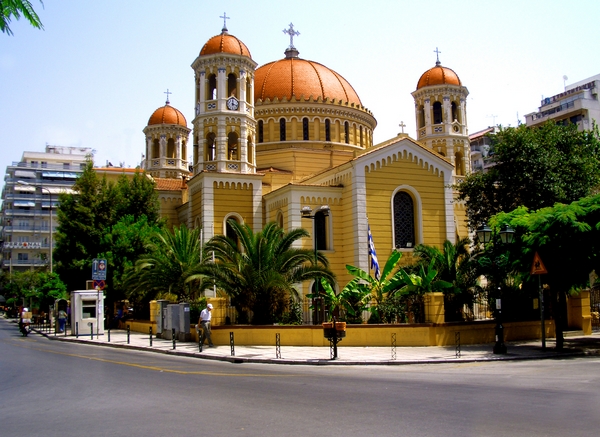You are here: » Christianity in View » Introduction to the Orthodox Church » The Saints
 Overview
Overview
As in the Roman Catholic church, Orthodoxy regards the saints as individuals who have exhibited an outstanding degree of holiness in their lives. A committee would be set up to research a potential saint, and determine whether or not their name should be added. It is of course essential that the individual concerned has shown conformity to Orthodox teaching. Formal recognition usually comes through holding a special service (known as a glorification).
The Orthodox church maintains a whole list of feast days for all its saints and people are encouraged to venerate and pray to them, asking for their intercession. Again, in a similar way to Catholicism, the church carefully distinguishes between veneration and worship.
We now turn to look at two important saints who have played an important part in shaping the Orthodox faith as we know it today.
 John Chrysostom (347-407)
John Chrysostom (347-407)
John was born in Antioch in 347. Originally his aim was to study law, but he later decided to study for the priesthood, being ordained in 386. It was in his position as priest that John began to forge a reputation as an eloquent preacher and orator (The word ‘Chrysostom’ comes from the Greek: chrysostomos, ‘Golden Mouthed’). His homilies and clear expositions of biblical principles established him as an outstanding teacher.
In 398, John was consecrated Patriarch of Constantinople. Although he was now in a powerful position, John emphasised his bond with ordinary people and the necessity of simple living. His attempts to reform the clergy proved unpopular, and he ended up losing favour with the Emperor Arcadius and (particularly) his wife Eudoxia, as John frequently had alluded to their lavish lifestyle. In 403, Eudoxia and the Alexandrian patriarch Theophilus managed successfully to press for John’s teachings to be investigated. At the so-called ‘Synod of the Oak’, John was unfairly condemned and exiled. However, his popularity meant that this decision was soon reversed. John did not however relax his contempt for the worldly living of those around him and he soon found himself in exile once again. He died in 407 and it is reported that his last words were “Glory be to God for all things.”
John’s legacy was firstly in his preaching style: his homilies were deep and insightful and he sought to emphasise the literal truths of scripture and how they might be applied to everyday life. Secondly, he made revisions to the liturgy as used in the celebration of the Eucharist. To this day, the most common liturgy used in the Orthodox Church is that called the ‘Divine Liturgy of our father amongst the saints: John Chrysostom.’
 Gregory Palamas (1296-1359)
Gregory Palamas (1296-1359)
Gregory was born in 1296, probably in Constantinople. After the death of his father, he decided to become a Monk, eventually moving with his two Brothers to Mount Athos in Greece, the spiritual centre of Orthodox monasticism. It was here that Gregory became acquainted with the Hesychast tradition (Greek: hesychia, ‘quietness’). Hesychasm is a form of deep meditation and contemplation (see the section ‘Orthodoxy’ for more information on this).
Around 1336 a dispute began between Gregory and Barlaam, a monk from Calabria, Italy. Barlaam had visited Mount Athos and began to investigate the teachings of the Hesychasts. Supporters of Gregory claimed that although God was ultimately unknowable in his essence, it was possible, through spiritual development, to experience his ‘uncreated light’ or ‘energy’. The Hesychasts drew attention to the occasion in the Bible where Jesus was transfigured on Mount Tabor. It was this energy that could be experienced by Man as part of gaining theosis, or union with God whilst on earth. Opponents of Hesychasm argued that the division between essence and energies was inconsistent with the unity and transcendence of God.
In 1341, a synod was held at Constantinople to hear the two opposing factions. Gregory’s defence proved persuasive and Barlaam was condemned. The dispute did not end, however, and Gregory found himself condemned and eventually imprisoned in 1344. Gregory’s triumph came in 1347, when he was released, eventually being elected Bishop of Thessalonica. A council in 1351 further confirmed the Orthodoxy of Hesychast teaching.
Gregory’s influence on Orthodox theology is significant and Hesychasm remains an important part of Orthodox spirituality to this day.

Metropolitan Church of Saint Gregory Palamas, Thessaloniki, Greece
 More Information:
More Information:
Here is a selected series of links that will give more information:
Gregory Palamas | John Chrysostom |
 Wise words:
Wise words:
“Because the Deity is goodness itself, true mercy and an abyss of loving bounty… we can receive mercy only by union with Him.”

St. Gregory Palamas
(1296-1359)